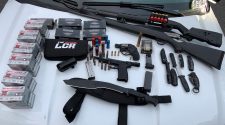The USMNT went up against Trinidad and Tobago in their second Gold Cup match, Holy Water in hand, and excised some demons. This was the first time since THAT night in Couva, only the second competitive match the full senior team has played since then, so there was some redemption out there to be had. There were a handful of players who played that night: Michael Bradley, Christian Pulisic, Paul Arriola, all on the starting XI. Pulisic said it himself, he played with a chip on his shoulder. The players had something to prove, and they went out and proved it.
Berhalter put in an unchanged lineup from the 4 – nil stomping of Guyana and it worked out. The team opened up a little bit stale. The USMNT were able to get in font of goal and get a few shots off, but nothing close enough to actually take the lead. On the other end, however, Trinidad was able to put some real pressure, getting down the field on the break and seriously testing Steffen with some long shots. The US might have dominated the possession and the shots, but T&T were there to make a game of it. That is, until the US scored. After smacking a set piece ball into a wall, Pulisic picked it back up and put an perfect cross in for Aaron Long to score off the back post. Fifteen minutes into the second half, Zardes made it two. From there the rout was on and the score jumped up to six, all from the run of play. For too long, at least as far back as when Klinsmann was struggling against Guatemala and Jamaica, the small teams have looked at the USMNT and said “You know what, maybe we can take ‘em”. We saw that with Guyana trying to play into the US just a few nights ago. Well, this result was a first step in restoring the old status quo, of restoring the USMNT’s reputation back such that the small nations bunker in fear that they’ll get dunked on six -nil.
And, with that, here’s some takeaways from that six goal display.
From A to Zardes
So Zardes went and started another game and, you know what, he had a really good match. I know an awful lot of you love to bash on him for his limitations, but as the resident Guy-Who-Consistently-Points-Out-When-Zardes-Actually-Plays-Well™, it’s my job to point out that he actually played well. Today, I don’t really want to talk about his excellent work rate or his one-touch finishing or his (very much improved) first touch. Let’s get into how Zardes put himself into the game.
If you were watching for it, you could see from the start of the match that Zardes was playing differently than usual. Normally, he keeps a pretty high line, pushing the center backs back, mostly staying off the ball, and making runs to turn crosses and cutbacks into one-touch goals. This time, however, Zardes wasn’t staying off the ball. He spent a lot more time checking back towards midfield, getting into possession. It’s very much stuff that, say, Jozy Altidore, would do, but not at all what we’ve seen from Zardes. This was important as it helped pull the center backs away from the backline, forcing them to make a choice and either concede the space in front of the backline and let Zardes make plays, or move up and mark him and make room for Pulisic, Arriola, or Boyd to make a run. In the past, there was a legitimate fear that, if Zardes were to be passed the ball in space in front of the backline, that it would bounce ten feet off his foot and straight to a defender. But that’s not 2019 Gyasi Zardes. Instead, Zardes got on the ball and connected all right. The problem really was that the runs were not timed right and not incisive enough, while Zardes himself was a little pedestrian on his passing and slow to get the ball from his feet. He wasn’t actively bad, but the sum total of the play wasn’t enough to take the US from getting flashes and crosses in front of goal, to actual goals.
In the second half, there was a few adjustments. Zardes wound up getting more time on the ball. You can see it in his first goal. Zardes gets on the ball and brings it into the box. Now that he’s running in front of the backline, Trinidad and Tobago is forced to make a choice. Either a center back steps and tries to win the ball (which likely would lead to Zardes or Pulisic getting in on goal) or have a center mid check back and contest the ball. T&T chose the later, with Cordell Cato coming inside to close down the ball. That, in turn, put Michael Bradley into space. Zardes put in a back pass to Bradley, who spotted the (very high) run of Nick Lima and put him through. Nick Lima got on the ball and put in a cross and, boom, Zardes tap-in. It was a gorgeous sequence and an excellent example of Berhalter’s philosophy. You can see just how having possession of the ball pulls the defenders out of position and create space for the US to attack.
However, I’m not done with Zardes just yet. I want to spend a moment and look at what runs Zardes makes. I’ve got both goals here and they both show exactly where Zardes makes a run. Whether it is high up the field or in the box, Zardes picks exactly the position where he can split the center backs. In his first goal, after passing back to Bradley, Zardes immediately picks out his position a few feet in front of the backline. The moment the ball is switched over to Lima on the flank, Zardes is on the move, making a hard run towards goal… and then goal.
With his second, Zardes makes the same run, just much higher up the field. At the start of the clip, with Pulisic on the ball at the wing, Zardes is already on a run, ready to go straight at the keeper if a ball is played out in front of him. However, Pulisic instead chooses to cut inside. The young Chelsea-winger catches the attention of the entire T&T defense, pulling one of the center backs a step forward. And this is when Pulisic plays a simple slip ball into Zardes. Zardes responded to Pulisic’s run by pushing AWAY from the ball, but keeping in between the center backs. As a result, with everyone getting sucked towards Pulisic, Zardes has ample room to pick his play. And he just so happens to pick and absolute gorgeous curler into the back of the net.
Successful and smart attackers are attackers who make these kinds of simple runs time and time again, who are constantly aware of where they are relative to defenders while off the ball. I learned to watch this stuff from watching Robin van Persie play. And Zardes learned it from watching Robbie Keane play with him. Why does Zardes keep getting playing time? Because he makes these runs all day, every day. He makes them even when they aren’t noticed and rewarded by his teammates. And he makes them when things are going well.
The Texas Kid
You know who else decided to really come out to defend Gyasi Zardes? Weston McKennie.
McKennie had an alright first half. After being noticeably absent against Venezuela and modestly improved against Guyana, McKennie picked up where he left off and started the game against T&T with some marginal improvement. He got into a few more duels than he did in the first game, went and challenged a bit more, and had a peach of a pass or two. But he wasn’t really as involved as you really need your box-box midfielder to really be.
And then things changed in the second half.
First, McKennie shifted a little deeper. He started getting more involved, contesting more balls, covering more ground, and making more good passes. And then, Zardes got into a tuff with some T&T players. McKennie came flying out of nowhere, straight in the face of the opposing players, ready to fight to defend his teammate. It got him a yellow card (and he should watch it because another yellow in the next two games will make him miss a match) but it was awesome to watch. Here’s a 20 year old player rushing in, fire in his eyes, ready to defend his teammate. You could see glimpses of the kind of fight and passion that players like Dempsey and Jermaine Jones brought to the team. And, from that point on, McKennie was determined to put his stamp on the game. Now, he was EVERYWHERE. He was connecting passes across the field, dueling T&T players anytime they even thought about getting down the field. He was string passes and breaking up plays and taking shots. His rebounded shot led to Long’s second and the team’s sixth goal. I mean he almost scored from a bicycle kick. McKennie was absolutely on fire, the kind of midfield presence this team has been missing for years.
I’ve been saying for a few games at this point that this team needs someone to win the ball in midfield. Tyler Adams is the penciled in name for that job, but, with him injured, that role has gone unfulfilled. And I’ve repeatedly named McKennie as a candidate to cover that space. He didn’t really do that in the first 30 or so minutes. Trinidad was able to break and get down the field all together too easily, with Long and Zimmerman and Steffen forced to break up the attack and recover the ball. But after that? McKennie came into the game and locked it down. From there, T&T had almost nothing going forward, and a huge reason for that is McKennie.
Mix and Match
There were a lot of big performances in this game, but arguably the best came from the biggest star, with Christian Pulisic nabbing a goal and two assists. But he didn’t really have the best first half. He was a bit slow to connect, wasn’t taking players on on the dribble, and not making the most incisive runs. But by the end of the game, he was doing this:
What happened? Well, there were a few adjustments made team-wide.
For starters, the match didn’t feature that oft-derided RB/CM role. Instead, Nick Lima played more as a modern fullback, overlapping hard down the field. He’s actually done this for a few games and it demonstrates a willingness for Berhalter to tinker from the initial plan. But that wasn’t the only tinkering. I’ve already mentioned how Zardes came on the ball more and how McKennie tucked inside. But Pulisic also made a change. As the game progressed, Pulisic spent more and more time on the left wing. It’s not an accident that the opener came from Pulisic picking the ball up on the left and putting in a cross. Instead of starting centrally, Pulisic drifted over to the left and cut inside all through out the second half. And it brought dividends, with Pulisic regaining his confidence and burying Trinidad.
But that wasn’t the only change. All through the first half, Tyler Boyd stood out as a particularly bright spot. He didn’t quite have his shooting laces tied quite right, but he was, by far, the brightest and most active player in the attack, cutting inside and making incisive runs. But Berhalter took him out in the 60th minute. What’s going on? Well, aside from the possibility/probably that Berhalter wanted to protect Boyd, the MLS staff reviewing the game pointed out that the change responded to how T&T changed their approach. I’ve mentioned many, many times about how, since 2014, teams have figured out that pressing Michael Bradley suffocates the USMNT’s ability to hold possession and kills the team’s attack. Well, after falling behind and well on the path towards elimination, T&T started pushing forward to go after Bradley. And the US responded by putting on Jordan Morris, a speedy winger who, instead of cutting inside like Boyd, stayed wide and pushed up the field. With T&T trying to push forward, there was space for Morris (and Pulisic, Arriola, Zardes, and Lima) to exploit. Morris took that space in spades and got two assists for his troubles. In response to a winger running in behind, T&T corrected and tried to cover ground. And that relieved the pressure from Bradley.
The US needed to figure out how to cope when Michael Bradley got targeted. I’ve said it before, but it’s very, very weird for teams to target deep lying midfielders for a selective press. When teams try to close down on a player as deep as Bradley, they have to send multiple players. As a result, the defending team has to make a choice, either to let those players be disconnected from the rest of the team (opening space between that line) or moving the entire team forward to maintain spacing (and thereby opening up space in behind). This means that there’s space SOMEWHERE on the field. But the US was SO dependent on Bradley to move the ball, that, when he got shut down, the whole team got shut down. A lot of people have responded by criticizing Bradley for not handling the press. But, again, it’s weird to be pressed that deep on the pitch. Players in those positions are not expected to be able to perfectly deal with that. Instead, the path to victory is to play around the press and exploit the space. The US did that against Trinidad. And they did that well.
With this win, the USMNT are through to the knockout stages of the Gold Cup. Thanks to Curaçao’s victory over Honduras, the US won’t have to face Los Catrachos in the tournament. Instead, Honduras are out and the US will have to meet either Jamaica, Curaçao, or, more likely, El Salvador, in the quarterfinals. If the US advances (they really should advance), the US will play the winner of the reverse fixture, likely the winner between Panama and Jamaica. This means that the US lucked out and, along with the extremely favorable planned format, doesn’t have to play Costa Rica, Canada, Mexico, or Honduras until the final. I don’t know about you, but with how the team has been playing in this tournament, I think that final run is the expectation.
The USMNT returns to play their final group stage game against Panama on June 26th. A win or a draw will take them top of the group (thanks to goal difference). Meanwhile, the USWNT are already in the knockout stages of the World Cup. You can watch them take on Spain on June 23rd.




_(1)_(1)-225x125.jpg)












